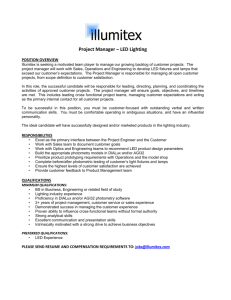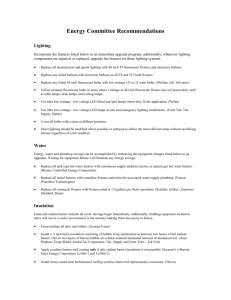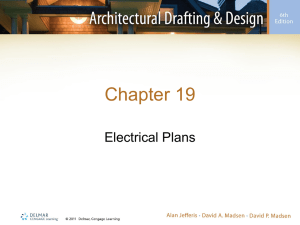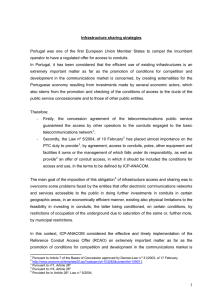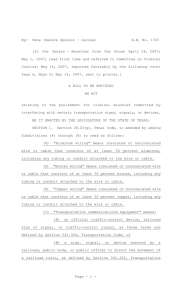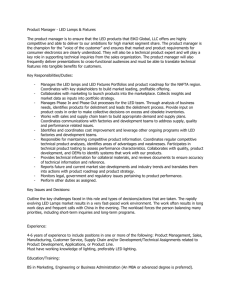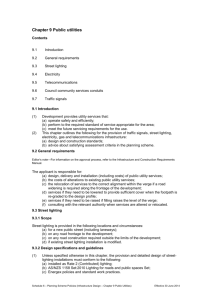Design Criteria
advertisement
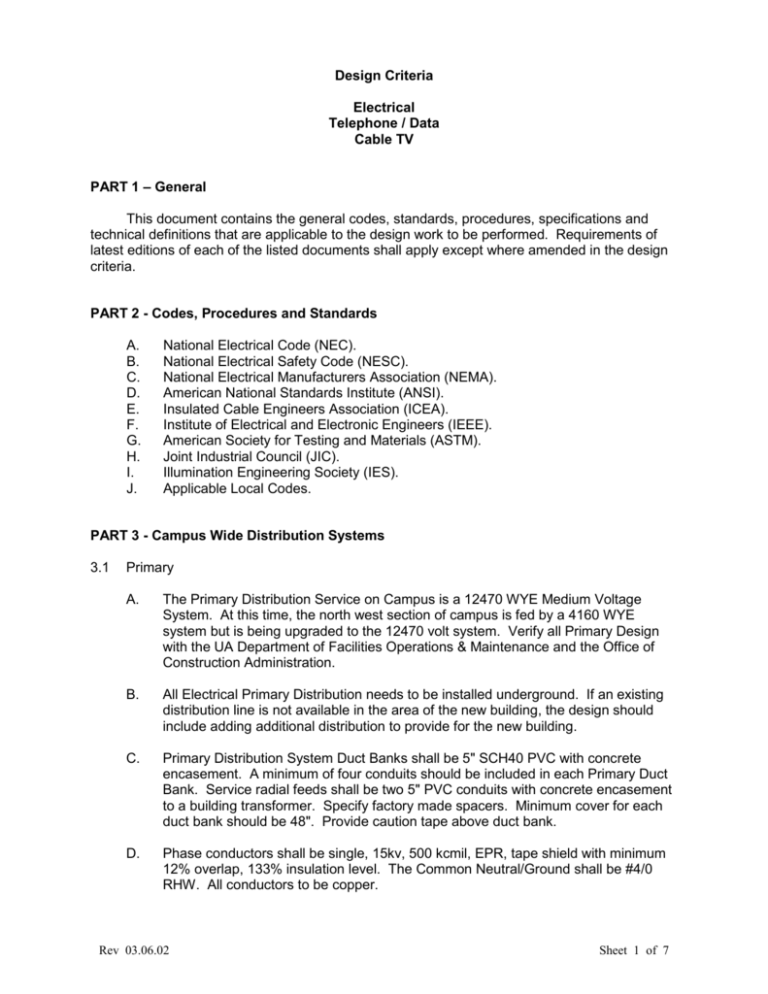
Design Criteria Electrical Telephone / Data Cable TV PART 1 – General This document contains the general codes, standards, procedures, specifications and technical definitions that are applicable to the design work to be performed. Requirements of latest editions of each of the listed documents shall apply except where amended in the design criteria. PART 2 - Codes, Procedures and Standards A. B. C. D. E. F. G. H. I. J. National Electrical Code (NEC). National Electrical Safety Code (NESC). National Electrical Manufacturers Association (NEMA). American National Standards Institute (ANSI). Insulated Cable Engineers Association (ICEA). Institute of Electrical and Electronic Engineers (IEEE). American Society for Testing and Materials (ASTM). Joint Industrial Council (JIC). Illumination Engineering Society (IES). Applicable Local Codes. PART 3 - Campus Wide Distribution Systems 3.1 Primary A. The Primary Distribution Service on Campus is a 12470 WYE Medium Voltage System. At this time, the north west section of campus is fed by a 4160 WYE system but is being upgraded to the 12470 volt system. Verify all Primary Design with the UA Department of Facilities Operations & Maintenance and the Office of Construction Administration. B. All Electrical Primary Distribution needs to be installed underground. If an existing distribution line is not available in the area of the new building, the design should include adding additional distribution to provide for the new building. C. Primary Distribution System Duct Banks shall be 5" SCH40 PVC with concrete encasement. A minimum of four conduits should be included in each Primary Duct Bank. Service radial feeds shall be two 5" PVC conduits with concrete encasement to a building transformer. Specify factory made spacers. Minimum cover for each duct bank should be 48". Provide caution tape above duct bank. D. Phase conductors shall be single, 15kv, 500 kcmil, EPR, tape shield with minimum 12% overlap, 133% insulation level. The Common Neutral/Ground shall be #4/0 RHW. All conductors to be copper. Rev 03.06.02 Sheet 1 of 7 E. Radial feeds to building transformers shall be the same as above except size at #2/0. The Neutral/Ground shall be #2/0 RHW. All conductors to be copper. F. Medium Voltage Switches 1. 2. 3. 4. G. Isolation Switches shall be 15kv, S&C Padmount, Type PMH or Equal. The switch should include fusible sections for a radial feed to the new building's transformer. Fusing should be S&C Type SML-20. Manufacturer to be S&C or Shallbetter Minimum Accessories: a. 12" Base Spacer, Non-Compartmented. b. Lightning Arresters. c. Four foot hot stick. Medium Voltage Transformers 1. Transformers to be on the 12470-volt system should have a 12470-volt primary with integral bay-o-net fuses in series with ELSP fuses. 2. Transformers to be on the 4160-volt system should have a 4160/12470 DUAL VOLTAGE primary with bay-o-net fuses in series with ELSP fuses. 3. Live front construction. 4. Manufacturer to be Cooper, Square D or General Electric 5. Minimum Accessories: a. Standard taps with external operator. b. Liquid level gauge. c. Pressure/Vacuum gauge. d. Pressure relief valve. e. Fill plug and drain valve. f. Lightning arresters. 3.2 Secondary Secondary Duct Banks shall be 2" SCH40 PVC conduits without encasement. A minimum of four 2" conduits should be installed on top of the encasement of each Primary Duct Bank. Minimum cover for each bank should be 24". In-ground junction boxes should be rated for Light Traffic Duty. 3.3 Telephone, Data and Cable TV A. The UA Telecommunications Office and the UA Computer Center provide the telephone and data system cables. The systems are installed underground through conduit and manholes. B. Comcast Cable Co provides Cable TV distribution. Some distribution is over-head, some is underground. Some cables are included in the Telecommunications Duct Bank. C. New buildings will require service from the nearest telephone manhole. If an existing manhole is not available in the area of the new building, the design should include adding additional distribution to provide for the new building. D. Duct Banks for Telephone, Data and Cable TV systems shall be a minimum of four 4" PVC without encasement. Minimum cover for each Duct Bank should be 30". Manholes will need to be provided with the Users specifications. Rev 03.06.02 Sheet 2 of 7 PART 4 - Building Services 4.1 General All building services need to be provided. Under this section, the minimum services would be Power, Telephone, Data and Cable TV. See other sections for Gas, Water, Sewer, etc. 4.2 4.3 Electrical Service A. Buildings should be served from a pad-mounted transformer connected to the primary distribution system via a medium voltage switch and fuses. See Distribution Section. B. Electrical service shall be provided to an electrical service panel or switchboard in each building. The service needs to be located in a separate electrical room and be sized for future expansion. C. A surge suppression system shall be installed on each electrical service. The system should be sized for service entrance protection. D. Provide for extra spaces in all panelboards. All extra spaces should include bussing and fingers for future circuit breakers. E. An Emergency Generator should be supplied on academic and administrative buildings. The generator should be fed by natural gas except for some applications that may require a diesel engine. F. A kilowatthour meter needs to be installed for each service. 1. The meter should be a three element, electronic kWh meter. 2. The meter should indicate kWh and kW demand. 3. The meter should be mounted in the service entrance panel. If the service entrance panel does not provide metering, a socket-mounted meter may be used. 4. Socket mounted meters to be Schlumberger Vectron SVX or equal. 5. Each meter socket should include a 10-point test block. 6. Each meter needs to be connected to the service with a color-coded multiconductor meter cable. 7. The meter should include a pulse-initiating device with a maximum pulse frequency of 1 pulse/second and a minimum pulse width of 500 msec for the anticipated load. This device should pulse a set of dry form-c contacts providing a pulse constant of 1 Wh/pulse to the KYZ outputs on the meter. 8. Also provide one ¾” conduit with three #14 AWG stranded color-coded wires from the KYZ terminals at the meter to the Building Management System. 9. See metering detail at end of the criteria. Telephone, Data and Cable TV Service A. Telephone, Data and Cable TV shall require four 3" Sch40 conduits to be provided from an existing manhole to a backboard in a telecommunications closet. B. Cables and terminations will be by others. Rev 03.06.02 Sheet 3 of 7 C. Each floor of each building should have a Telephone and Data closet with a backboard for distribution of communications wiring. Minimum size should be 100 sq. ft. Recommend each closet for each floor to be vertically aligned. This will help in future additions of conduit and wire. D. Each wall of the closet needs to have power strips 8 inches from the floor with outlets 6 inches on center. Include one circuit per wall. E. Each closet should have airflow or cooling. Confirm with Telecommunications Department. PART 5 - Building Systems Minimum Requirements 5.1 Power Systems A. Major Equipment 1. Energy consumption shall be considered in the design of the electrical system and in the purchase of electrical equipment. 2. All material shall be new. 3. All line items shall be by one manufacturer. 4. Dry-Type Transformers to have copper windings. 5. Busways to be silver coated copper. 6. Equipment to be manufactured by Allen-Bradley, Square D, General Electric or Siemens. 7. Panelboards a. Should be surface mounted in electrical closet wherever possible. If closets are definitely not available, the panelboards may be flush mounted in a hallway. b. Load centers are not acceptable. c. Include extra conduits for future use. d. Provide for minimum 20% spare spaces. e. Panelboards to have copper bussing. 8. Molded case circuit breakers shall be bolt-on type. 9. Electric motors 1/2 Hp and above should be 3 phase. 10. Disconnects shall be heavy-duty type. 11. Contactors, Motor Controllers and Motor Control Centers. a. Contactors and motor controllers to be NEMA type. IES type are not acceptable. b. Minimum motor controller size to be NEMA Size 1. c. Magnetic controllers shall include a Control Circuit Transformer for each starter for 120 volt control power. d. MCC’s to have copper bussing. e. Controllers for "Local" control to have "Start-Stop" Pushbuttons on the controller enclosure. f. Controllers for "Remote" control to have "Hand-Off-Auto" selector switches on the controller enclosure. g. Pilot Lights to be transformer type. h. Pilot Lights to be "Push to Test" type. i. Pilot Lights for FVNR Starters. 1) "Red" light indicates "Running". 2) "No light" indicates "Not Running". j. Pilot Lights for Reversing Starters. 1) "Red" light indicates "FORWARD". Rev 03.06.02 Sheet 4 of 7 l. 2) "Amber" light indicates "REVERSE". Pilot Lights for Two Speed Starters. 1) "Red" light indicates "FAST". 2) "Amber" light indicates "SLOW". B. Wiring & Wiring Devices 1. All conductors shall be copper with a min. conductivity of 98%. 2. Each feeder and branch circuit shall have an equipment-grounding conductor pulled with the phase conductors. 3. Provide #12 AWG minimum wire size. Homeruns over 100' to be #10 AWG. 4. Wiring devices shall be Specification Grade, side wired devices. 5. Unless specified by User, the wiring devices should be gray with a stainless steel device plate. 6. Standard 125 volt outlets to be 20 amp minimum. Do not use 15 amp outlets. 7. Provide receptacles in all rooms with finished walls. As a minimum these outlets should include the following: a. General Offices: One outlet for 10' of wall space. b. Offices: One outlet per wall. c. Vending machines: One per machine, each on a separate circuit. 8. Provide Ground Fault Circuit Interrupters where required by NEC and approximately one every 100 ft. on the exterior of the building with a weatherproof cover. 9. Outlet boxes shall be standard hot-dipped galvanized steel with knockouts. 10. All wiring to be installed in conduit. Use no Metal Clad cables. 11. Provide for two extra sets of spare fuses, max. of 10 each size. C. Conduits 1. All exposed exterior conduits shall be galvanized rigid or IMC. 2. Interior conduits may be EMT with non-cast couplings. 3. Non-metallic conduits to be PVC, Schedule 40. PVC to be used only in concrete slabs or underground. Underground bends greater than 45 degrees and risers to above grade shall be galvanized rigid or IMC. 4. All transitions from below ground to above ground to have the conduit coated with tape or a bitumastic compound 6" on either side of the transition. 5. All empty conduits to have a pull-wire installed. Use metal pull-wire in all underground PVC conduits. E. Lightning Protection Lightning protection system should be installed on all buildings having an exterior elevation greater than 3 stories. Design and shop drawings should be provided by a company that specializes in this work. Conductors, air terminals and other devices should be copper or copper based material unless the building's roofing material requires the use of aluminum. 5.2 Lighting Systems A. In general, indoor lighting should be fluorescent and outdoor lighting should be metal halide. B. Wherever possible use standard 4 ft., T8, 4100-degree lamps with electronic ballasts. Keep U-lamp use to a minimum. Rev 03.06.02 Sheet 5 of 7 C. Low Mercury fluorescent lamps should be specified for all fixtures. Lamps should be Philips type Alto or equal. D. Any Emergency Battery Units should include an external switch & pilot light for testing purposes. E. Miniature fluorescent lamps may be used for downlights and some other applications but insure that the lamps and ballasts have more than one manufacturer before selecting the fixture. F. Variable Lighting Levels should be accomplished by multiple switching of lighting circuits. G. Dimming should be used only where audio/visual or theatrical presentations will be done. Use incandescent lamps for dimming, not fluorescent lamps. Dimming systems for A/V rooms should be verified with user. Prefer CRESTRON SYSTEM 10 unless user specifies otherwise. Dimming systems for theatres should be verified with user. H. Utilize the most energy efficient type lamps, ballasts and fixtures for each application. I. Design indoor lighting levels for the upper level of maintained illuminance as recommended by IES for an area. J. Do not exceed the manufacturer's recommended spacing criteria for the fixtures to be used. Where the number of fixtures required for adequate distribution of light is greater than the number required for the specified lighting level, use the number required for distribution. K. Outdoor lighting control should be by a photocell-controlled contactor with a local "auto-on" switch. L. Provide entrance lighting at all entrances and perimeter lighting around the building. M. Lenses on metal halide fixtures should be glass, not acrylic or polycarbonate. If a particular fixture must be used for a specific location and glass is not available, use the lens that has the better UV protection to minimize the yellowing of the lens. N. Exit Lights should be GREEN LED. O. Exterior Pole lighting is indicated in the detail drawings at the end of this section. This may not be applicable to some installations. Other poles and fixtures can be discussed. Include an in-line fuse at each pole. P. Sports Lighting should be 1500-watt Metal Halide fixtures on spun concrete poles. Galvanized steel poles may be discussed for some applications. The fixtures should minimize spill light by the use of an internal faceted reflector. External hoods are not acceptable. Rev 03.06.02 Sheet 6 of 7 5.3 Auxiliary Systems A. Telephone and Data Systems 1. Provide a deep double-gang wall box with a 3/4" conduit from box up to an accessible location above the ceiling. 2. Front entrance areas, as a minimum, should have one wall mounted telephone in each area. Other common areas may also require other telephone outlets. 3. Wiring to be provided by others. B. Cable TV 1. Cable TV may be requested by the User. Provide a two gang wall box with a 3/4" conduit from the box to an accessible location above the ceiling. 2. Wiring to be provided by others. C. Fire Alarm System 1. The system shall be a Simplex type 4100. Type 4020 may be used on smaller buildings. 2. Fire Alarm system should have addressable devices. 3. Pull stations in housing buildings should have tamper alarms. 4. Locate Fire Alarm Control Panel or an appropriate annunciator at the building entrance to be used by the Fire Department. 5. Fire Alarm System wiring type and colors to be specified by Simplex. D. Areas of Rescue Assistance 1. Provide communication system at code required locations. 2. Communication system to be CORNELL or equal. 3. Locate central station at the building entrance to be used by the Fire Department. E. Access Control On doorways selected by the Architect or User: 1. Each doorway to the exterior should have an electric latch, door contacts and a crash bar with an internal “Request to Exit” switch. Instead of electric latch, the User may request a door holding magnet. 2. Voltage for all devices to be 24VDC. 3. On the exterior wall, provide a wall box for a card reader. 4. On the interior wall, provide a wall box for a "Request to Exit" push button. 5. See detail sketch at the end of this section. F. Security Systems 1. Verify security requirements with the User and the Security Section of the Department of Public Safety. 2. Provide conduits, wiring and systems as requested. Rev 03.06.02 Sheet 7 of 7

